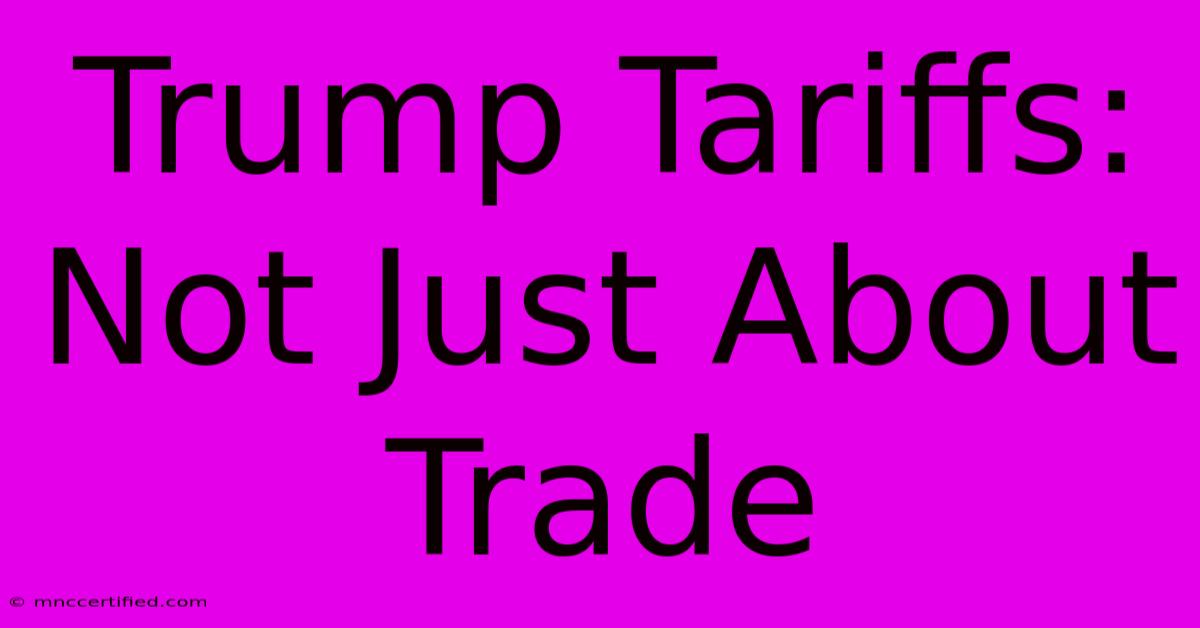Trump Tariffs: Not Just About Trade

Table of Contents
Trump Tariffs: Not Just About Trade – A Deeper Dive into Economic and Geopolitical Impacts
The Trump administration's tariffs, implemented between 2018 and 2020, sent shockwaves through the global economy. While often framed as a trade dispute, their impact extended far beyond simple import-export balances, touching upon complex economic and geopolitical landscapes. This article delves deeper than the headlines, exploring the multifaceted consequences of these controversial policies.
Beyond Trade Wars: The Broader Implications of Trump's Tariffs
The narrative surrounding the Trump tariffs often focused on a trade war with China. While this was a significant component, the reality was far more nuanced. The tariffs targeted various countries and sectors, reflecting a broader agenda that intertwined economic strategy with geopolitical ambitions.
1. The "America First" Economic Strategy:
At its core, the tariff strategy aimed to bolster American manufacturing and reduce the trade deficit. The argument was that protecting domestic industries through tariffs would lead to job creation and economic growth within the US. This "America First" approach prioritized national interests above multilateral trade agreements and global economic cooperation. However, the effectiveness of this strategy remains heavily debated.
2. Geopolitical Leverage and Power Plays:
The tariffs were also used as a tool of geopolitical leverage. The administration used them to pressure trading partners, attempting to renegotiate trade deals and address perceived unfair trade practices. This approach, while assertive, strained relationships with key allies and created uncertainty in the global marketplace. The tariffs on steel and aluminum, for example, impacted not only China but also close allies like Canada and the European Union, highlighting the geopolitical complexities.
3. Unintended Consequences and Economic Ripple Effects:
The tariffs didn't just impact targeted industries; they created widespread ripple effects throughout the global economy. Increased prices for imported goods led to inflation, impacting consumers and businesses alike. Supply chains were disrupted, leading to production delays and shortages. Farmers, particularly soybean producers, faced significant losses due to retaliatory tariffs imposed by China. These unintended consequences highlighted the interconnectedness of the global economy and the limitations of unilateral trade policies.
Analyzing the Long-Term Effects: Did the Tariffs Achieve Their Goals?
The long-term effects of the Trump tariffs are still unfolding, and economists continue to debate their overall impact. While some sectors experienced temporary gains, the overall economic consequences were arguably negative. The rise in prices, supply chain disruptions, and retaliatory tariffs negatively impacted many sectors of the US and global economy. The promised surge in domestic manufacturing jobs largely failed to materialize.
Looking Ahead: Lessons Learned and Future Trade Policies
The Trump tariffs serve as a cautionary tale about the complexities of trade policy and the potential unintended consequences of protectionist measures. While the goal of protecting domestic industries is understandable, the implementation and broader implications of these tariffs require careful consideration. Future trade policies need to balance national interests with global cooperation and recognize the interconnectedness of the world economy. A more nuanced approach, focusing on targeted interventions rather than broad-stroke tariffs, may be necessary to achieve sustainable economic growth and strengthen international relationships.
Keyword Optimization and SEO Strategy:
This article uses a variety of keywords and phrases related to the Trump tariffs, including:
- Primary Keywords: Trump tariffs, trade war, economic impact, geopolitical implications, America First, trade policy
- Long-tail Keywords: Trump administration tariffs, effects of Trump tariffs on US economy, Trump tariffs and China, consequences of protectionist trade policies, global impact of Trump tariffs, retaliatory tariffs, supply chain disruptions due to tariffs
On-Page SEO: The article uses H2 and H3 headings to structure the content logically. Bold text highlights key phrases. The keyword density is optimized naturally, without keyword stuffing.
Off-Page SEO: To further boost search engine rankings, consider promoting this article through social media, guest blogging, and building high-quality backlinks from relevant websites. Engaging in relevant online discussions and forums can also increase visibility. The article's informative and insightful nature also contributes to its potential for organic search traffic.

Thank you for visiting our website wich cover about Trump Tariffs: Not Just About Trade. We hope the information provided has been useful to you. Feel free to contact us if you have any questions or need further assistance. See you next time and dont miss to bookmark.
Featured Posts
-
Lithuania Dhl Crash Sabotage Alleged
Nov 27, 2024
-
Fact Check Morgan Freemans Hand
Nov 27, 2024
-
Glastonbury 2024 Stewart First Act
Nov 27, 2024
-
Sporting Cp Arsenal Live Match Updates
Nov 27, 2024
-
Man City Feyenoord 3 3 November 26th
Nov 27, 2024